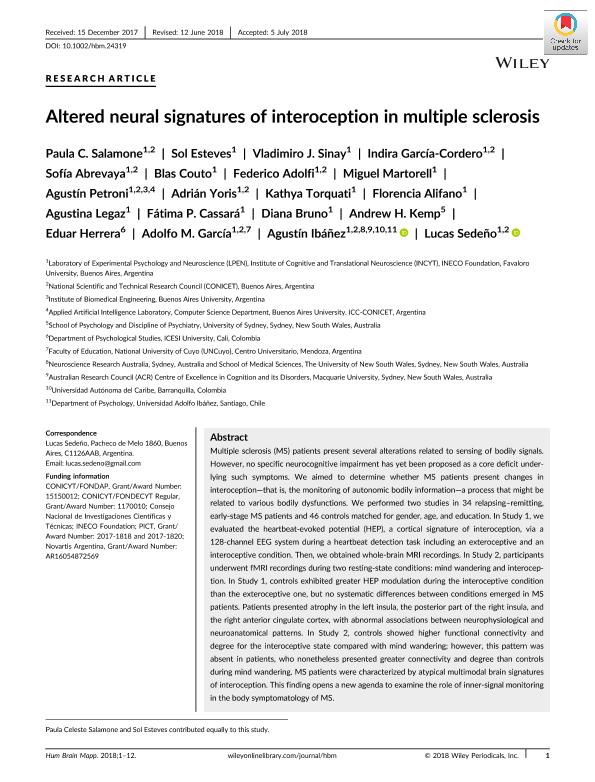Artículo
Altered neural signatures of interoception in multiple sclerosis
Salamone, Paula Celeste ; Esteves, Sol; Sinay, Vladimiro J.; García Cordero, Indira Ruth
; Esteves, Sol; Sinay, Vladimiro J.; García Cordero, Indira Ruth ; Abrevaya, Sofia
; Abrevaya, Sofia ; Couto, Juan Blas Marcos
; Couto, Juan Blas Marcos ; Gonzalez Adolfi, Federico
; Gonzalez Adolfi, Federico ; Martorell Caro, Miguel Angel
; Martorell Caro, Miguel Angel ; Petroni, Agustín
; Petroni, Agustín ; Yoris, Adrián; Torquati, Kathya; Alifano, Florencia; Legaz, Agustina
; Yoris, Adrián; Torquati, Kathya; Alifano, Florencia; Legaz, Agustina ; Cassará, Fátima P.; Bruno, Diana; Kemp, Andrew H.; Herrera, Eduar; García, Adolfo Martín
; Cassará, Fátima P.; Bruno, Diana; Kemp, Andrew H.; Herrera, Eduar; García, Adolfo Martín ; Ibañez, Agustin Mariano
; Ibañez, Agustin Mariano ; Sedeño, Lucas
; Sedeño, Lucas
 ; Esteves, Sol; Sinay, Vladimiro J.; García Cordero, Indira Ruth
; Esteves, Sol; Sinay, Vladimiro J.; García Cordero, Indira Ruth ; Abrevaya, Sofia
; Abrevaya, Sofia ; Couto, Juan Blas Marcos
; Couto, Juan Blas Marcos ; Gonzalez Adolfi, Federico
; Gonzalez Adolfi, Federico ; Martorell Caro, Miguel Angel
; Martorell Caro, Miguel Angel ; Petroni, Agustín
; Petroni, Agustín ; Yoris, Adrián; Torquati, Kathya; Alifano, Florencia; Legaz, Agustina
; Yoris, Adrián; Torquati, Kathya; Alifano, Florencia; Legaz, Agustina ; Cassará, Fátima P.; Bruno, Diana; Kemp, Andrew H.; Herrera, Eduar; García, Adolfo Martín
; Cassará, Fátima P.; Bruno, Diana; Kemp, Andrew H.; Herrera, Eduar; García, Adolfo Martín ; Ibañez, Agustin Mariano
; Ibañez, Agustin Mariano ; Sedeño, Lucas
; Sedeño, Lucas
Fecha de publicación:
12/2018
Editorial:
Wiley-liss, Div John Wiley & Sons Inc
Revista:
Human Brain Mapping
ISSN:
1065-9471
Idioma:
Inglés
Tipo de recurso:
Artículo publicado
Clasificación temática:
Resumen
Multiple sclerosis (MS) patients present several alterations related to sensing of bodily signals. However, no specific neurocognitive impairment has yet been proposed as a core deficit underlying such symptoms. We aimed to determine whether MS patients present changes in interoception—that is, the monitoring of autonomic bodily information—a process that might be related to various bodily dysfunctions. We performed two studies in 34 relapsing–remitting, early‐stage MS patients and 46 controls matched for gender, age, and education. In Study 1, we evaluated the heartbeat‐evoked potential (HEP), a cortical signature of interoception, via a 128‐channel EEG system during a heartbeat detection task including an exteroceptive and an interoceptive condition. Then, we obtained whole‐brain MRI recordings. In Study 2, participants underwent fMRI recordings during two resting‐state conditions: mind wandering and interoception. In Study 1, controls exhibited greater HEP modulation during the interoceptive condition than the exteroceptive one, but no systematic differences between conditions emerged in MS patients. Patients presented atrophy in the left insula, the posterior part of the right insula, and the right anterior cingulate cortex, with abnormal associations between neurophysiological and neuroanatomical patterns. In Study 2, controls showed higher functional connectivity and degree for the interoceptive state compared with mind wandering; however, this pattern was absent in patients, who nonetheless presented greater connectivity and degree than controls during mind wandering. MS patients were characterized by atypical multimodal brain signatures of interoception. This finding opens a new agenda to examine the role of inner‐signal monitoring in the body symptomatology of MS.
Archivos asociados
Licencia
Identificadores
Colecciones
Articulos(OCA HOUSSAY)
Articulos de OFICINA DE COORDINACION ADMINISTRATIVA HOUSSAY
Articulos de OFICINA DE COORDINACION ADMINISTRATIVA HOUSSAY
Articulos(SEDE CENTRAL)
Articulos de SEDE CENTRAL
Articulos de SEDE CENTRAL
Citación
Salamone, Paula Celeste; Esteves, Sol; Sinay, Vladimiro J.; García Cordero, Indira Ruth; Abrevaya, Sofia; et al.; Altered neural signatures of interoception in multiple sclerosis; Wiley-liss, Div John Wiley & Sons Inc; Human Brain Mapping; 39; 12; 12-2018; 4743-4754
Compartir
Altmétricas



